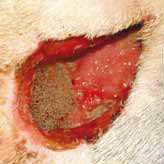Difference between revisions of "Maggot Therapy - Donkey"
Jump to navigation
Jump to search
m (Text replace - '|rspace={{Donkey}} |pagetype=Donkey }}' to '|pagetype=Donkey }} {{infotable |Maintitle = This section was sponsored and content provided by '''THE DONKEY SANCTUARY''' |Maintitlebackcolour = B4CDCD }} [[Cat) |
|||
| Line 20: | Line 20: | ||
|sublink1 = Wound Management - Donkey | |sublink1 = Wound Management - Donkey | ||
|subtext1 = Wound Management - Donkey | |subtext1 = Wound Management - Donkey | ||
| − | |||
|pagetype=Donkey | |pagetype=Donkey | ||
}} | }} | ||
| + | {{infotable | ||
| + | |Maintitle = [[Sponsors#The Donkey Sanctuary|This section was sponsored and content provided by '''THE DONKEY SANCTUARY''']] | ||
| + | |Maintitlebackcolour = B4CDCD | ||
| + | }} | ||
| + | [[Category:Donkey]] | ||
Revision as of 10:28, 25 February 2010
| This article has been peer reviewed but is awaiting expert review. If you would like to help with this, please see more information about expert reviewing. |

The Donkey Sanctuary has had two successful experiences using sterile maggots to treat deep infected necrotic wounds in donkeys. Sterile larvae of the common greenbottle, Lucilia sericata, supplied by the Surgical Materials Testing Laboratory (SMTL) were used to debride wounds where conventional therapy had failed (Bell and Thomas 2001; Thiemann, 2003).
References
- Thiemann, A. (2008) Surgery In Svendsen, E.D., Duncan, J. and Hadrill, D. (2008) The Professional Handbook of the Donkey, 4th edition, Whittet Books, Chapter 16
- Bell, N.J., Thomas, S. (2001). ‘Use of sterile maggots to treat panniculitis in an aged donkey’. Veterinary Record 149. pp 768-770.
- Thiemann, A.K. (2003). ‘Treatment of a deep injection abscess using sterile maggots in a donkey’. World Wide Wounds website. November 2003 (www.worldwidewounds.com)
|
|
This section was sponsored and content provided by THE DONKEY SANCTUARY |
|---|